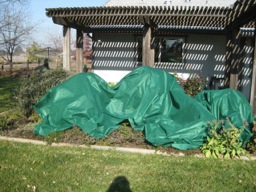 Sometimes
a gardener feels as if they're in a heavyweight boxing match: Your
Tender Plants vs. Mr. Freeze. Your citrus, succulents and perennials
that may thrive in milder climates might be able to take a frosty punch
or two here in the Sacramento/San Joaquin Valleys, foothills, and inland
portions of the Bay Area. But several cold blows to the
flowers, leaves, stems and roots?
Sometimes
a gardener feels as if they're in a heavyweight boxing match: Your
Tender Plants vs. Mr. Freeze. Your citrus, succulents and perennials
that may thrive in milder climates might be able to take a frosty punch
or two here in the Sacramento/San Joaquin Valleys, foothills, and inland
portions of the Bay Area. But several cold blows to the
flowers, leaves, stems and roots? We aren't talking about light frosts, or temperatures that hover around 30 degrees (F) for a couple of hours; that would be normal; the possibility of a frost in Sacramento is anytime between November and late March. The most typical frost period here is December and January. Usually by late February, gardeners thoughts - mistakenly - have turned to planting warm season annuals and putting away the frost cloths for the season. What area gardeners are going through right now is several days of extended hours of below freezing overnight temperatures, with prolonged bouts of plant-killing cold in the mid-to-low 20's.
So, what should a shivering gardener do...after a hard freeze, when temperatures are at or below 28 degrees for several consecutive hours? Should they:
a)
remove all plants that look frost-bitten;
b) prune away all freeze-damaged plant
parts;
c)
Purchase and plant again this month those same varieties of trees,
shrubs, perennials and annuals;
d) Water the garden, even if the plants resemble toast;
e) Fight the urge to
prune and plant by staying indoors, next to the wood stove.
The answers happen to be the easiest to accomplish on a cold weekend: d) and e).
If plants in your garden look blackened and wilted now, new growth may emanate from the base of the plant when the weather warms up in a couple of months.
 |
| New growth beneath the frosted branches of a geranium. |
Pruning away the dead
portions now exposes buds that may still be alive; another frosty
morning could wipe out those survivors. Keep the shears in the garage and let the dead portions of the plants
protect the understory.
It may take until mid-Spring before you see new
growth. Patience is key before you pick up the pruners. In the meantime, tolerate the ugly.
Make sure your garden and
potted plants remain moist, especially if it isn't raining. Water gives
off heat, and this can protect plants from freezing, especially
borderline citrus trees, such as lemons and limes. Damp soil retains
heat better than dry soil, protecting roots and warming the air near the
soil.
Succulents, such as cactus, are the exception, however. According to the Arizona-based Desert Botanical Garden, most succulents survive freezing temperatures best if the soil around them is dry.
 |
| It's dead, Jim. |
Some
of those dead plants may be summer annuals that survived our unusually mild early and mid-winter. This impatiens, for example took its sweet time to croak. Mornings hovering around 25 degrees
can do that to a summer annual. Put them in the compost pile; plant more
in the spring, after all danger of frost.
 |
| Frosty the Ficus |
What about those
plants that have frozen past the point of no return? Should you replace them with the same varieties? That frozen
ficus may be Mother Nature's way of telling you: "Hey! This ain't San
Diego! Pick outdoor plants that can take colder temperatures!"
Oh, and keep your frost protection gear handy...just in case.
Oh, and keep your frost protection gear handy...just in case.






